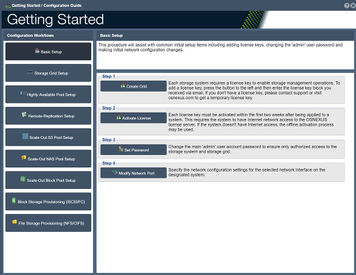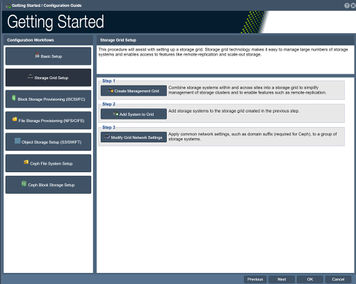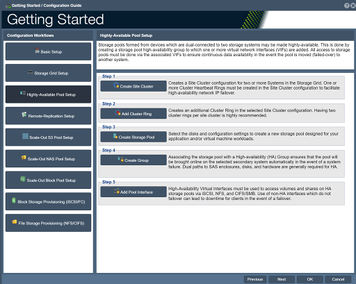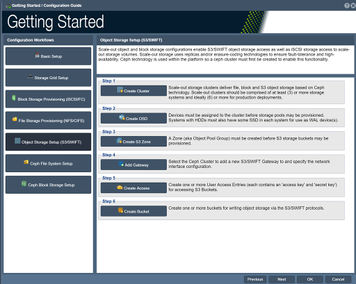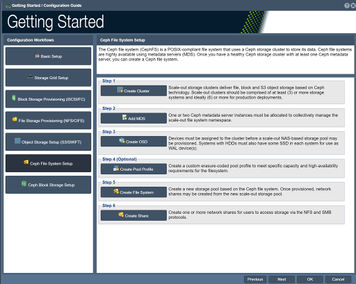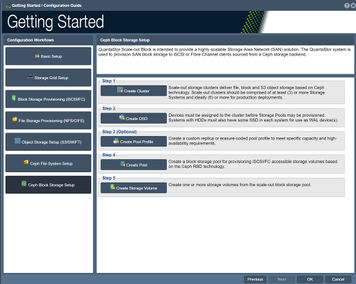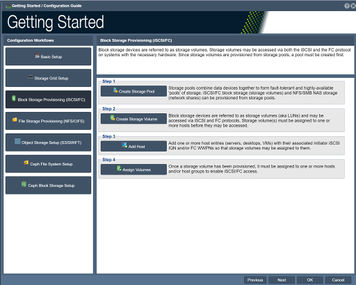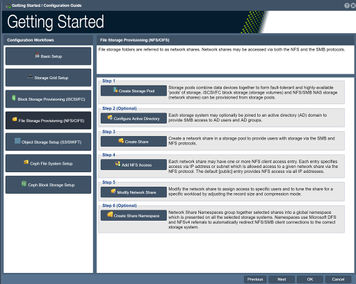Overview (Getting Started)
Getting Started/Configuration Guide
Navigation: Storage Management --> Storage System --> Storage System --> Getting Started (toolbar)
Contents
Basic Setup
This procedure will assist with the initial setup items including adding license keys, changing the 'admin' user password and making initial network configuration changes.
-Step one guides one to create a grid.
-Step two guides one to Activate a license.
-Step three guides one to change the Administrator's Password.
-Step four guides one to setup the Network Configuration.
Storage Grid Setup
This procedure will assist with setting up a Storage Grid. Storage Grid technology makes it easy to manage large numbers of Storage Systems and enables access to features like remote-replication and scale-out storage.
-Step one guides one to Create a Storage Grid.
-Step two guides one to Add Storage Systems to the Storage Grid.
-Step three guides one to Modify the Storage Grid Network Settings.
High-availability Pool Setup
Storage pools formed from devices which are dual-connected to two storage systems may be made highly-available. This is done by creating a storage pool high-availability group to which one or more virtual network interfaces (VIFs) are added. All access to storage pools must be done via the associated VIFs to ensure continuous data availability in the event the pool is moved (failed-over) to another system.
Step One
Object Storage Setup (S3/SWIFT)
Scale-out Object and Block storage configurations enable S3/SWIFT object storage access as well as iSCSI storage access to scale-out Storage Volumes. Scale-out storage uses replicas and/or erasure-coding technologies to ensure fault-tolerance and high-availability. Ceph technology is used within the platform so a Ceph Cluster must first be created to enable this functionality.
-Step one guides one to Create an Object Storage Cluster.
-Step two guides one to Create Object Storge Devices, OSD's.
-Step three guides one to Create an S3/SWIFT Object Storage Zone, prior to provisioning of S3 storage buckets.
-Step four guides one to Select a Ceph Cluster for the S3/SWIFT Gateway.
-Step five guides one to the Creation of User Access Entries.
-Step six guides one to Create buckets for writing object storage via the S3/SWIFT protocols
Ceph File System Setup
The Ceph Filesystem, CephFS, is a POSIX-compliant filesystem that uses a Ceph Storage Cluster to store its data. Ceph File Systems are highly available using Metadata Servers, MDS. Once you have a healthy Ceph Storage Cluster with at least one Ceph Metadata Server, you can create a Ceph Filesystem.
-Step one guides one to Create an Object Storage Cluster.
-Step two guides one to Add a Metadata Server, MDS.
-Step three guides one to Assign Devices to the cluster before a scale-out NAS-based storage pool may be provisioned.
-Step four guides one to Create a Ceph Pool Profile (optional).
-Step five guides one to Create a File System.
-Step six guides one to Create a Share for user access via NFS or SMB.
Ceph Block Storage Setup
QuantaStor Scale-out Block is intended to provide a highly salable Storage Area Network solution where the QuantaStor system is used to provision SAN block storage to iSCSI or Fiber-Channel clients sourced from a Ceph storage backend.
-Step one guides one to Create an Object Storage Cluster.
-Step two guides one to Create Object Storage Devices, OSD's.
-Step three guides one to Create a Custom Replica or erasure-coded pool profile (optional).
-Step four guides one to Create block Scale-out Storage Pools, Ceph Pools.
-Step five guides one to Create Scale-out Storage Volumes, Ceph RBDs.
Block Storage Provisioning (iSCSI/FC)
This procedure will assist with setting up Storage Pools and Volumes.
-Step one guides one to Create a Storage Pool. Pools must be created before Volumes.
-Step two guides one to Create a Volume.
-Step three guides one to Add a Host Initiator.
-Step four guides one to Assign a Volume.
File Storage Provisioning (NFS/CIFS)
File storage folders are referred to as Network Shares. Network Shares may be accessed via both the NFS and the SMB protocols.
-Step one guides one to Create a Storage Pool.
-Step two guides one to Setup an Active Directory (optional).
-Step three guides one to Create a Network Share via SMB or NFS protocall.
-Step four guides one to Add NFS Share.
-Step five guides one to Modify a Network Share.
-Step six guides one to Create a Share Namespace.
